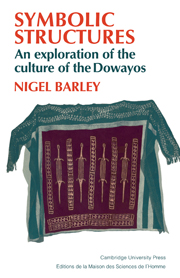Book contents
- Frontmatter
- Contents
- Acknowledgments
- Preface
- 1 The ethnographic background
- 2 Symbolism and the punctuation of culture
- 3 Some problems of the representational model of symbolism
- 4 The leopard cannot change his spots
- 5 Water and fertility
- 6 Tarniisnohgbarklele: ‘the place where the old Fulani woman was beaten to death’
- 7 ‘It is only thanks to me that you were circumcised’
- 8 The seasons of the year and the joker in the pack: relations of nesting and quotation
- Appendix: The festivals
- Notes
- Bibliography
- Index
4 - The leopard cannot change his spots
Published online by Cambridge University Press: 07 May 2010
- Frontmatter
- Contents
- Acknowledgments
- Preface
- 1 The ethnographic background
- 2 Symbolism and the punctuation of culture
- 3 Some problems of the representational model of symbolism
- 4 The leopard cannot change his spots
- 5 Water and fertility
- 6 Tarniisnohgbarklele: ‘the place where the old Fulani woman was beaten to death’
- 7 ‘It is only thanks to me that you were circumcised’
- 8 The seasons of the year and the joker in the pack: relations of nesting and quotation
- Appendix: The festivals
- Notes
- Bibliography
- Index
Summary
If it were possible to use the simple representational model of the analysis of cultural symbols in anything but a trivial way – and I in no way rule out this possibility for other cultures which may be much more ‘lexical’ (Saussure 1974: 133) than the Dowayo – then this might happen in at least two ways. First, it might be possible to establish culture-wide themes. We can easily imagine a culture where pots clearly always ‘were’ wombs in any usage that we wished to term symbolic. The dreamed-of dictionary of symbols could be written instead of simply being assumed to exist, perhaps with one or two very large terms and a certain amount of polysemy and homonymity, but conforming to the exigencies of lexicographical semiology. To interpret a ritual, we should merely have to look up the entries of the symbols used, make some allowance for selectional limitations of meaning, interpret actions performed on/with them in terms of syntax and insert the whole into an appropriate context. This has at least the benefit of perhaps being susceptible to formalisation and being a sufficiently layered operation to give some scope for subtlety. A concentration on ‘appropriate context’ would give the Douglas (of 1975: 249) sort of interpretation; a concentration on the dictionary, the Turner (of 1967: 19).
- Type
- Chapter
- Information
- Symbolic StructuresAn Exploration of the Culture of the Dowayos, pp. 39 - 49Publisher: Cambridge University PressPrint publication year: 1983

